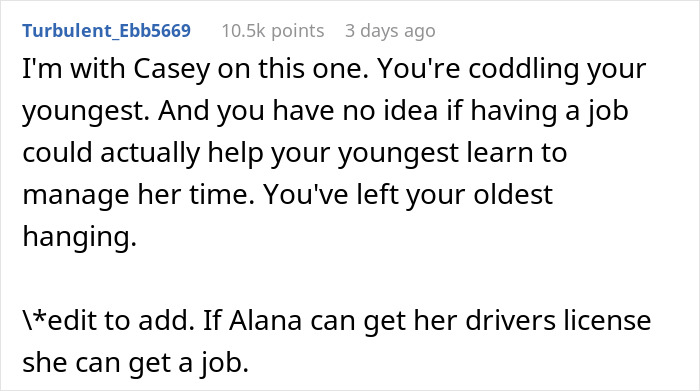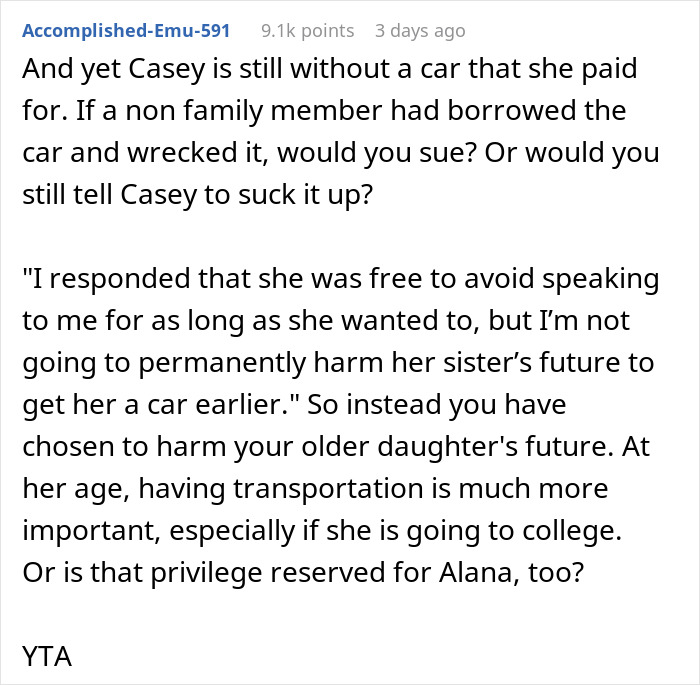Buying your first car is a huge milestone, and it certainly was for the teen girl in this Reddit story shared by her dad. She spent a full year working hard and saving every penny to reach her goal.
But the excitement didn’t last long—her younger sister took the car for a drive and crashed it. Furious and heartbroken, the teen stopped speaking to her entire family. Now, her parents are left trying to figure out how to handle the situation and mend the rift.
The teen girl had spent a year saving for her car, only for her sister to crash it

Image credits: Artyom Kulakov/Pexels (not the actual photo)
Heartbroken and furious, she’s now refusing to speak to her family




Image credits: Dương Nhân/Pexels (not the actual photo)



Image credits: Liza Summer/Pexels (not the actual photo)


Image credits: TopVersion2940
Teens are the most likely age group to get into a fatal car accident in the U.S.

Image credits: Andrea Piacquadio/Pexels (not the actual photo)
Driving may feel like second nature to experienced adults, but for teenagers, it’s much more dangerous. In the U.S., where it’s legal to drive before turning 18, every day about eight teens die due to motor vehicle crashes. In fact, those aged 16-19 are nearly three times more likely to be involved in fatal accidents than drivers over 20, making them the most at-risk group on the road.
Thankfully, the girl in the Reddit story didn’t suffer any long-term harm—just a broken arm and leg. But even minor injuries serve as a reminder of just how important safety is for younger drivers.
Inexperience is the main reason teens are more likely to get into accidents. They often aren’t as skilled as older drivers when it comes to judging and reacting to situations like merging onto highways, making tricky turns, or handling bad weather.
Teens may also lack the motor skills and judgment needed for complex driving maneuvers. They’re more likely to misjudge traffic, get distracted, speed, tailgate, text while driving, and forget to wear seat belts. Plus, peer pressure and mood swings, especially among boys, can push them into making careless choices behind the wheel.
What parents can do to help

Image credits: Kindel Media/Pexels (not the actual photo)
Parents can play a big role in helping reduce these risks. The American Academy of Pediatrics emphasizes that one of the most important steps is ensuring teens get plenty of driving practice. In the U.S., typical school driver’s education programs only offer about six hours of on-the-road training, but the time needed to become truly proficient is closer to fifty hours. Parents can encourage teens to take their time and build their skills through regular driving.
Once a teen has a learner’s permit, parents can help by gradually introducing more complex situations, like night driving, heavy traffic, and driving in bad weather. This hands-on experience is invaluable, and getting into the habit of letting your teen drive during errands can build their confidence and skills.
It’s also important to make sure the car they’re driving meets safety standards and that they know basic car maintenance, like checking tire pressure and changing a flat.
Lastly, parents need to set a good example. Avoid speeding, texting, and road rage, and always wear your seat belt. Teens learn a lot by watching their parents, so demonstrating safe driving habits can make a big difference.
Many commenters blamed the parents for letting the sister drive the car and not insisting she work to replace it















Some users defended the parents, saying they aren’t at fault and are handling the situation as best they can










